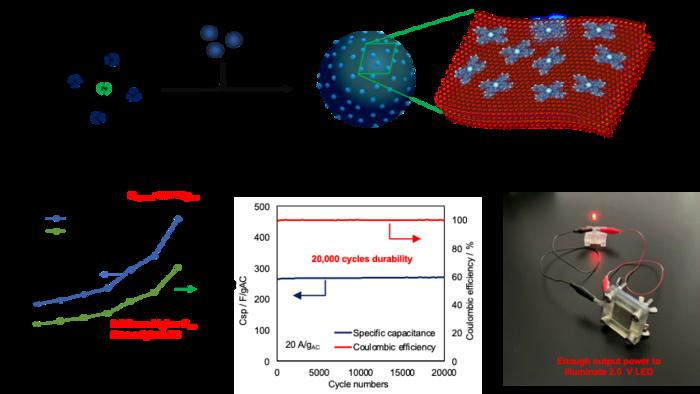Reviewed by Danielle Ellis, B.Sc.Sep 5 2024
In their quest for a more power-efficient future, researchers at Tohoku University have effectively boosted the capacity, lifespan durability, and cost-effectiveness of a capacitor, according to a study published in ACS Applied Materials & Interfaces.

Schematic diagram of activated carbon with adsorbed iron azaphthalocyanine molecules (top), Capacitance and Capacitance Increase Ratio relative to activated carbon alone (bottom left), Capacitance and Capacitance Retention Rate after repeated charge-discharge cycles at 20 A/gAC (bottom center), and LED lighting experiment using a simple charge-discharge cell with two capacitor cells connected in series (bottom right). Image Credit: Hiroshi Yabu
Similar to a battery, a capacitor is a device that can be used in a circuit to store and release energy. A capacitor charges considerably faster than a battery. This is how they vary from one another. For instance, the battery in the phone will power it up instantaneously, but it will take some time to charge the battery when it runs out fully.
Although this suggests that capacitors are a better option, there are a few significant disadvantages that must be addressed. They cannot simultaneously store significant amounts of energy because, first of all, their capacity is substantially lower than that of batteries. Second, they might be expensive.
Recently, nanocarbon materials, such as carbon nanotubes (CNTs), which improve the surface area and total capacity, have been used to make supercapacitors—capacitors with higher capacity and performance. However, adopting this approach for large-scale manufacturing is not cost-effective since nanocarbon materials are expensive.

Image Credit: Mentor57/Shutterstock.com
A research group led by Professor Hiroshi Yabu of Tohoku University, AZUL Energy Co., Ltd., a venture company from Tohoku University, and the AZUL Energy x Tohoku University Bio-Inspired GX Co-Creation Center was established to address these particular issues and enhance the overall performance of capacitors.
By “sprinkling” iron azaphthalocyanine (FeAzPc-4N), a type of blue pigment, onto activated carbon, the team increased the capacity of capacitors by 2.4 times (to 907 F/gAC) compared to carbon alone. This technique enables the molecule to adsorb at the molecular level by using its redox properties.
Furthermore, the research showed that 20,000 charge-discharge cycles can be achieved even in high-load regions with 20 A/gAC, indicating that LEDs can be powered.
This increased lifespan compared to batteries may help reduce waste, as the same capacitor can be reused many more times. The components of capacitors are also significantly less toxic than batteries.
Hiroshi Yabu, Professor, Tohoku University
The capacitor electrode produced in this study could enhance the capacity of supercapacitors employing CNTs while using readily accessible and affordable activated carbon, making it a promising alternative for next-generation energy devices. The team’s next move following this is to increase the supercapacitor’s power.
Journal Reference:
Ishibashi, K., et. al. (2024) A Molecular Adsorption Concept for Increasing Energy Density of Hybrid Supercapacitors. ACS Applied Materials & Interfaces. doi.org/10.1021/acsami.4c06084